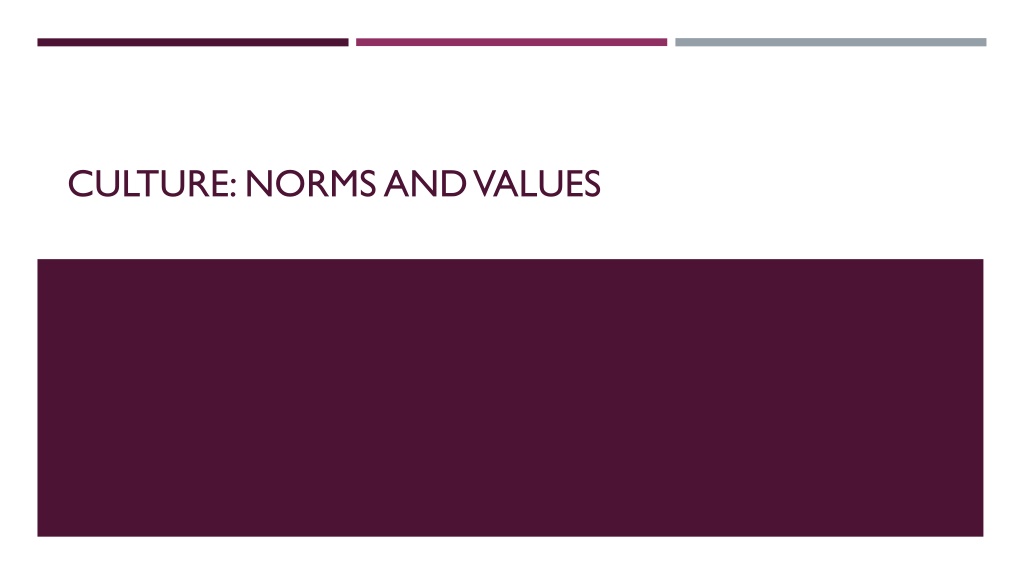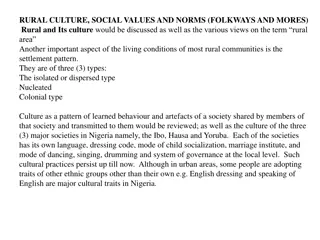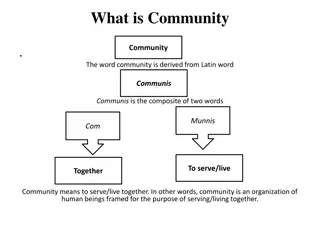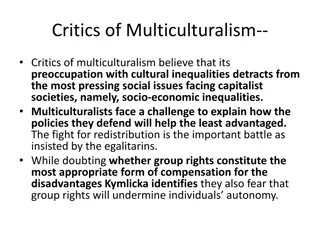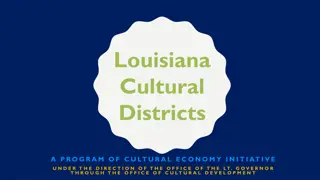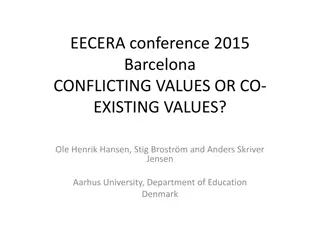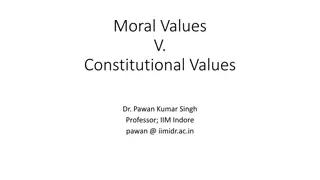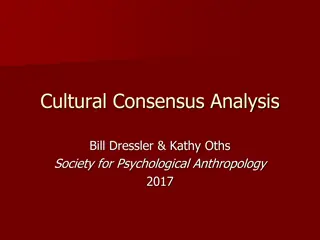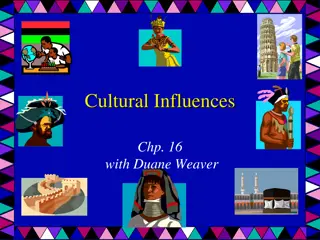Understanding Cultural Norms and Values
Sociologists define culture through norms, values, beliefs, and material objects. Norms are rules that govern behavior, with three basic types: folkways, mores, and laws. Folkways are customs without moral significance, mores are norms with moral importance, and laws are clearly defined and enforced norms. Violations can lead to social disapproval or legal consequences. Additionally, examples of "silly laws" from different states highlight unusual regulations.
Download Presentation

Please find below an Image/Link to download the presentation.
The content on the website is provided AS IS for your information and personal use only. It may not be sold, licensed, or shared on other websites without obtaining consent from the author. Download presentation by click this link. If you encounter any issues during the download, it is possible that the publisher has removed the file from their server.
E N D
Presentation Transcript
NORMS Norms: rules defining appropriate and inappropriate behavior Sociologists begin defining culture through its norms, values, beliefs, and use of material objects Norms help to explain why people in a society or group behave similarly in similar circumstances Norms are so ingrained they guide behavior without our awareness. We may not be aware of a norm until it has been broken. For example, if you want tickets to see a show, you stand in line at the ticket counter. You don t question that. But if someone tries to cut in front of you, you realize that behavior goes against the norm and you stop them.
3 BASIC TYPES OF NORMS Folkways Mores (pronounced More-A s) And Laws
FOLKWAYS Folkways- norms that lack moral significance These rules cover customary ways of thinking, feeling, and behaving. For example, we tend to sleep in bed rather than on the floor. But that isn t a moral issue. Folkways are not considered vital to group welfare, disapproval for those who break them is not great. Conformity is usually a matter of choice. For example, wearing shorts with a suit coat and tie or farting in public, may make us avoid these people, but we would not consider them to be evil or terrible people.
MORES Mores- norms that have moral significance and should be followed by society Moral means dealing with what is right and what is wrong. Conformity to mores is a social requirement. Examples include having multiple spouses or desecrating religious symbols all the way to arson and murder The most serious mores are taboos- a norm so strong that its violation calls for a strong punishment For example, cannibalism or the one constant taboo across every society is incest. Violations of taboos can be met with strong social disapproval or criminal consequences.
LAWS Law- a norm that is clearly defined and enforced by officials Laws are consciously created and enforced. Mores are an important source for laws. At one time the mores against murder was not written down, but societies advanced and the mores became formally defined an enforced. So laws usually used to be a mores or a folkway. The difference is that they are clearly defined and can be enforced and have clearly defined punishments; whereas the other two are not. For example, smoking in places open to the pubic was a folkway for a long time, now it is a law. Laws usually remain on the books for long after the mores of a society have changed.
SILLY LAWS Alabama- illegal for a driver to be blindfolded Arizona- illegal to hunt camels Florida- if an elephant is tied to a parking meter, the owner must pay for the meter Illinois- must contact the police before entering a city in an automobile Iowa- kisses may not last more than 5 minutes Maine- you must not step out of a plane mid flight Massachusetts- no gorilla in the backseat of a car Vermont- illegal to whistle underwater Washington- illegal to pretend that one s parents are rich Portland, Oregon- illegal to wear roller skates in public bathrooms
SANCTIONS Sanctions- rewards and punishments used to encourage people to follow norms People do not automatically conform to norms. They must be learned and accepted. They can be formal or informal. Formal Sanctions- sanctions imposed by persons give special authority like judges or teachers Can be positive (rewards) or negative (punishments). Do well in class, get an A in Sociology. Judges have recently started handing down sentences involving public shaming.
SANCTIONS Informal Sanctions- rewards or punishments that can be applied by members of a group They can also be positive or negative. Jumpstart somebody s car (positive). Staring at someone talking loudly in a movie (negative). After we reach a certain age, most of us conform without the threat of sanctions. In other words, we sanction ourselves.
VALUES Values- broad ideas about what is good or desirable shared by a society Values are very general. Thus different societies or groups within the same society have different norms based on the same value. For example take the value of freedom. In Russia leaders said their people were free because they provided full employment, medical care, and education. In America, we believe we are free because of freedom of speech, assembly, and the right to a representative government. Values have a huge influence on social behavior because they form the basis for norms. So values norms folkways, mores, laws enforced by sanctions
QUESTIONS 1. Indicate whether these statements reflect a (F) Folkway, a (M) Mores, a (L) Law, or a (V) Value. A. Norm against cursing aloud in church B. norm encouraging eating 3 meals daily C. idea of progress D. norm encouraging sleeping in a bed E. norm against burning a national flag F. norm against murder G. norm against overtime parking H. idea of freedom. 2. How are norms and values different from each other? Support with examples.
STANDARDS OF BEAUTY QUICK WRITE Who do you think set the standards (norms) for what Americans think is beautiful? Think in terms of both men and women. Advertisers, the media, ? Do you believe that being good looking is advantageous in society? Research confirms that people who are perceived to be physically attractive do seem to get more promotions. What does that say about our society?
PAMPHLET Create an article that could be distributed to teenage visitors from other cultures who will be spending a week with an American Family. First brainstorm to determine what types of information you think would be necessary to help guest feel more comfortable. Topics can include material concepts such as places to visit, typical foods, technology, and transportation. As well as nonmaterial concepts such as rules, family systems, and traditions.
VALUES CLARIFICATION Make a list of 10 things, both material and nonmaterial, that you value. Lists can include family, health, friends, honest, money, etc. Now rank them by the value you place on them. Most important = 1, least important = 10 If I gave you $1,000 to spend on these values, how would you spend it on your items? You can put it all on one value or you can spread it out however you want.
